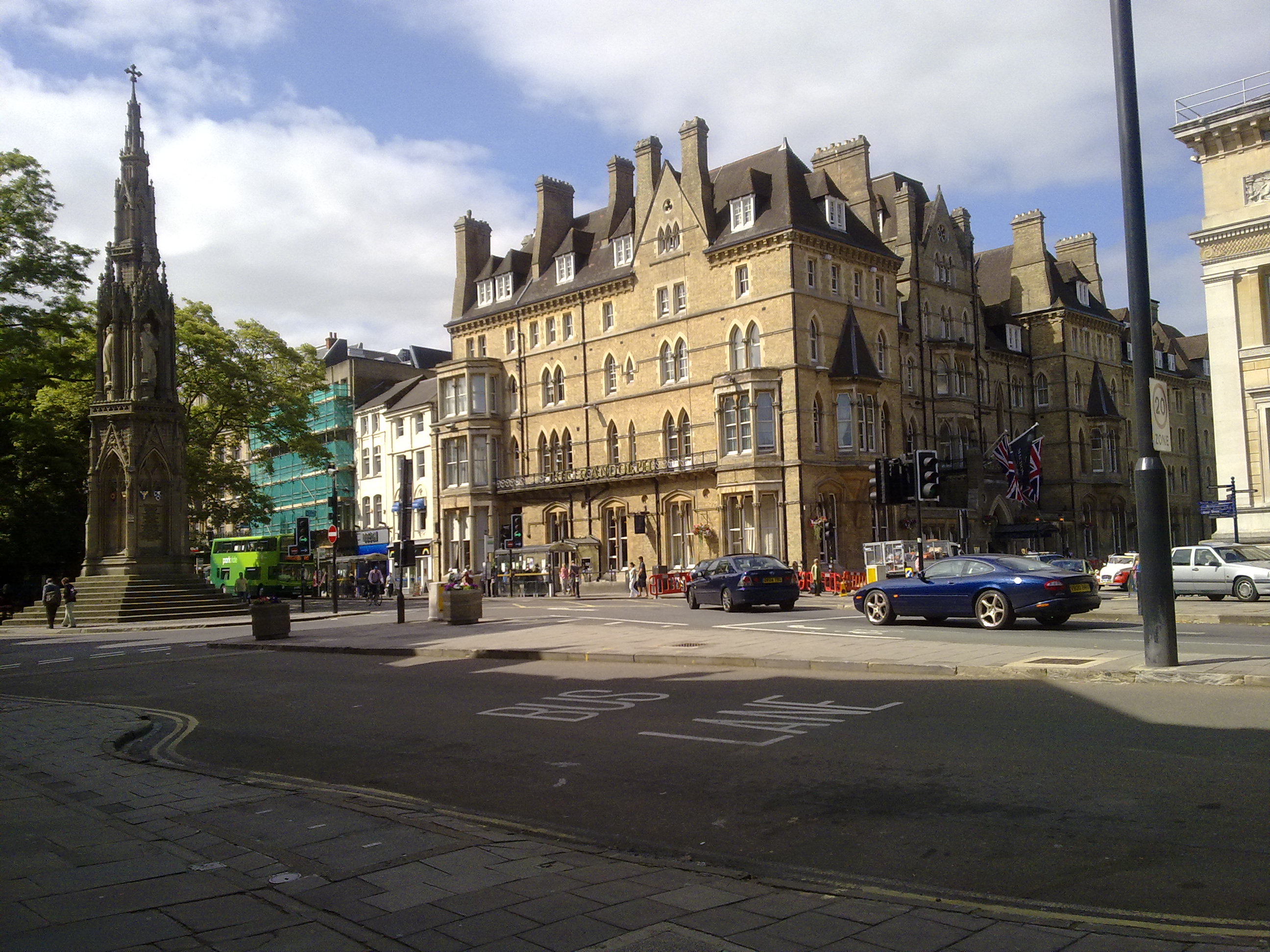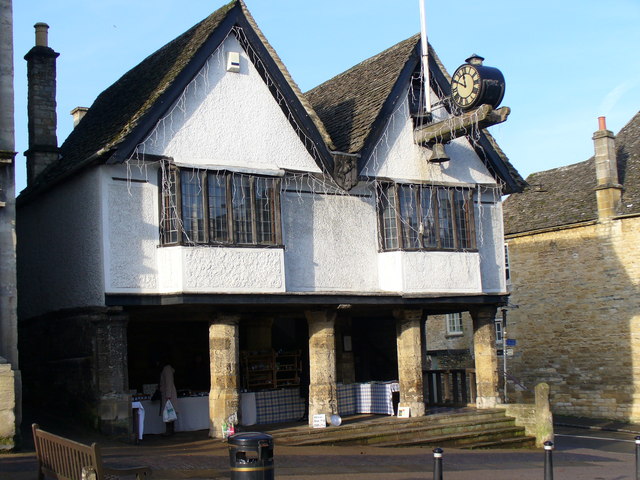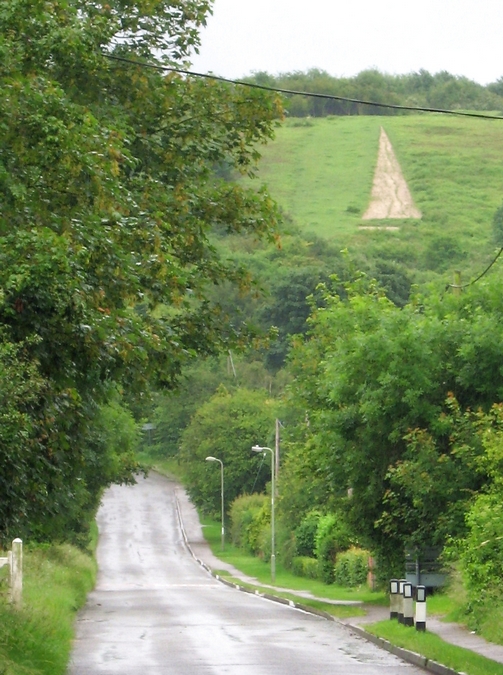|
William Wilkinson (architect)
William Wilkinson (1819–1901) was a British Gothic Revival architect who practised in Oxford, England. Family Wilkinson's father was a builder in Witney in Oxfordshire. William's elder brother George Wilkinson (1814–1890) was also an architect, as were William's nephews C.C. Rolfe (died 1907) and H.W. Moore (1850–1915). Career Most of Wilkinson's buildings are in Oxfordshire. His major works include the Randolph Hotel in Oxford, completed in 1864. He was in partnership with his nephew H.W. Moore from 1881. In his long career Wilkinson had a number of pupils, including H.J. Tollit (1835–1904). Works Churches In 1841, at the age of only 22, Wilkinson designed a new Church of England parish church, Holy Trinity at Lew, Oxfordshire. His other work on churches included: *St Leonard's parish church, Eynsham: restoration, 1856 *Witney Cemetery: lodge and two chapels, 1857 *Witney Workhouse: chapel, 1860 *All Saints' parish church, Middleton Cheney, Northamptonshire: ... [...More Info...] [...Related Items...] OR: [Wikipedia] [Google] [Baidu] |
Macdonald Randolph Hotel
The Randolph Hotel ("The Randolph") is a 5 star hotel in the heart of Oxford, England. It is on the south side of Beaumont Street, at the corner with Magdalen Street, opposite the Ashmolean Museum and close to the Oxford Playhouse. The hotel building is in the Victorian Gothic style. The hotel featured in the ''Inspector Morse'' television series several times, in particular in the episode entitled " The Wolvercote Tongue". The cast stayed at the hotel during filming in 1987 and there is now a Morse Bar. It was also in episodes of the followup series, "Lewis". History Construction of the Randolph Hotel began in 1864, to a design by William Wilkinson, an architect who also designed many houses in North Oxford. There was debate about the building's design. John Ruskin favoured Gothic revival like the nearby Martyrs' Memorial. The City Council wanted a classical style since the rest the buildings in Beaumont Street were early 19th century Regency. A compromise was attained wi ... [...More Info...] [...Related Items...] OR: [Wikipedia] [Google] [Baidu] |
Middleton Cheney
Middleton Cheney is a village and civil parish in West Northamptonshire, England. The village is about east of Banbury in Oxfordshire and about west-northwest of Brackley. The A422 road between Banbury and Brackley used to pass through Middleton Cheney, but now bypasses it to the south. The 2011 Census recorded the parish's population (including Thenford) as 3,597. Archaeology and history The village's name means 'Middle farm/settlement'. The village was held by John de Chendut in the 12th century. Traces of Neolithic, Bronze Age and Roman settlements have been found in the parish. An open field system of farming prevailed in the parish until the 18th century. Parliament passed an Inclosure Act for the parish in 1769 and the parish was surveyed for its inclosure awards in 1770. There is a row of 19th-century almshouses on the former main road through the village. In 1847 Parliament passed a bill for the Buckinghamshire Railway to build an extension to Banbury. It was buil ... [...More Info...] [...Related Items...] OR: [Wikipedia] [Google] [Baidu] |
English Country House
An English country house is a large house or mansion in the English countryside. Such houses were often owned by individuals who also owned a town house. This allowed them to spend time in the country and in the city—hence, for these people, the term distinguished between town and country. However, the term also encompasses houses that were, and often still are, the full-time residence for the landed gentry who ruled rural Britain until the Reform Act 1832. Frequently, the formal business of the counties was transacted in these country houses, having functional antecedents in manor houses. With large numbers of indoor and outdoor staff, country houses were important as places of employment for many rural communities. In turn, until the agricultural depressions of the 1870s, the estates, of which country houses were the hub, provided their owners with incomes. However, the late 19th and early 20th centuries were the swansong of the traditional English country house lifest ... [...More Info...] [...Related Items...] OR: [Wikipedia] [Google] [Baidu] |
North Oxford
North Oxford is a suburban part of the city of Oxford in England. It was owned for many centuries largely by St John's College, Oxford and many of the area's Victorian houses were initially sold on leasehold by the College. Overview The leafy roads of Woodstock Road to the west and Banbury Road to the east (leading to Woodstock and Banbury respectively) run north-south through the area, meeting at their southern ends to become St Giles. North Oxford is noted for its schools, especially its private schools. These include the Dragon School and Summer Fields (formerly Summerfield), which are preparatory schools, and St Edward's School and the Oxford High School for Girls, which are secondary schools, as well as St. Clare's, Oxford, an international sixth form college which is the longest provider of the International Baccalaureate Diploma in England (source ISA) Geography The boundary of "North Oxford" is not exactly defined, but the original area developed by St John's C ... [...More Info...] [...Related Items...] OR: [Wikipedia] [Google] [Baidu] |
Shirburn Castle
Shirburn Castle is a Grade I listed, moated castle located at the village of Shirburn, near Watlington, Oxfordshire. Originally constructed in the fourteenth century, it was renovated and remodelled in the Georgian era by Thomas Parker, the first Earl of Macclesfield who made it his family seat, and altered further in the early nineteenth century. The Earls of Macclesfield remained in residence until 2004, and the castle is still (2022) owned by the Macclesfield family company. It formerly contained an important, early eighteenth century library which, along with several valuable paintings, remained in the ownership of the 9th Earl and were largely dispersed at auction following his departure from the property; notable among these items were George Stubbs's 1768 painting "Brood Mares and Foals", a record setter for the artist at auction in 2010, the Macclesfield Psalter, and personal correspondence of Sir Isaac Newton. On account of its "fairy tale" external appearance and unmo ... [...More Info...] [...Related Items...] OR: [Wikipedia] [Google] [Baidu] |
Deddington
Deddington is a civil parish and small town in Oxfordshire about south of Banbury. The parish includes two hamlets: Clifton and Hempton. The 2011 Census recorded the parish's population as 2,146. Deddington is a small settlement but has a commercial centre including a market place, which hosts a popular monthly farmer’s market. It has been a market town probably since the 12th century. One of the Hundred Rolls of King Edward I from 1275–76 records Deddington as a borough. It has a deli, coffee shop, restaurant, three pubs and a town hall (see below). Its football team is called Deddington Town FC. Geography The parish is about wide east–west, about wide north–south and has an area of about . Watercourses bound it on three sides: The River Cherwell to the east, its tributary the River Swere to the north and the Sowbrook (''i.e.'' "South Brook") to the south. Here the Cherwell also forms the county boundary with Northamptonshire. To the west the parish is bounded by f ... [...More Info...] [...Related Items...] OR: [Wikipedia] [Google] [Baidu] |
Burford
Burford () is a town on the River Windrush, in the Cotswolds, Cotswold hills, in the West Oxfordshire district of Oxfordshire, England. It is often referred to as the 'gateway' to the Cotswolds. Burford is located west of Oxford and southeast of Cheltenham, about from the Gloucestershire boundary. The Toponymy, toponym derives from the Old English words ''burh'' meaning fortified town or hilltown and ''ford (crossing), ford'', the crossing of a river. The United Kingdom Census 2011, 2011 Census recorded the population of Burford parish as 1,422. Economic and social history The town began in the History of Anglo-Saxon England, middle Saxon period with the founding of a village near the site of the modern priory building. This settlement continued in use until just after the Norman conquest of England when the new town of Burford was built. On the site of the old village a hospital was founded which remained open until the Dissolution of the Monasteries by Henry VIII of Englan ... [...More Info...] [...Related Items...] OR: [Wikipedia] [Google] [Baidu] |
Chipping Norton, Oxfordshire
Chipping Norton is a market town and civil parish in the Cotswold Hills in the West Oxfordshire district of Oxfordshire, England, about south-west of Banbury and north-west of Oxford. The 2011 Census recorded the civil parish population as 5,719. It was estimated at 6,254 in 2019. History Pre-1800 The Rollright Stones, a stone circle north of Chipping Norton, reflect prehistoric habitation in the area. The town name means "market north town", with "Chipping" (from Old English ''cēping'') meaning "market". Chipping Norton began as a small settlement beneath a hill, where the earthworks of the motte-and-bailey Chipping Norton Castle can still be seen. The Church of England parish church dedicated to St Mary the Virgin stands on the hill next to the castle. Parts of today's building may date from the 12th century. It retains features of the 13th and 14th centuries. The nave was largely rebuilt in about 1485 with a Perpendicular Gothic clerestory. It is believed to have been ... [...More Info...] [...Related Items...] OR: [Wikipedia] [Google] [Baidu] |
Woodstock, Oxfordshire
Woodstock is a market town and civil parish, north-west of Oxford in West Oxfordshire in the county of Oxfordshire, England. The 2011 Census recorded a parish population of 3,100. Blenheim Palace, a UNESCO World Heritage Site, is next to Woodstock, in the parish of Blenheim. Winston Churchill was born in the palace in 1874 and buried in the nearby village of Bladon. Edward, elder son of King Edward III and heir apparent, was born in Woodstock Manor on 15 June 1330. In his lifetime he was commonly called Edward of Woodstock, but is known today as the Black Prince. In the reign of Queen Mary I, her half-sister Elizabeth was imprisoned in the gatehouse of Woodstock Manor. History The name Woodstock is Old English in origin, meaning a "clearing in the woods". The Domesday Book of 1086 describes Woodstock (''Wodestock, Wodestok, Wodestole'') as a royal forest. Æthelred the Unready, king of England, is said to have held an assembly at Woodstock at which he issued a legal code no ... [...More Info...] [...Related Items...] OR: [Wikipedia] [Google] [Baidu] |
Watlington, Oxfordshire
Watlington is a small market town and civil parish about south of Thame in Oxfordshire, near the county's eastern edge and less than from its border with Buckinghamshire. The parish includes the hamlets of Christmas Common, Greenfield and Howe Hill, all of which are in the Chiltern Hills. The 2011 Census recorded the parish's population as 2,727. History The Watlington area is likely to have been settled at an early date, encouraged by the proximity of the Icknield Way. The toponym means "settlement of Waecel's people" and indicates occupation from around the 6th century. A 9th-century charter by Æthelred of Mercia records eight 'manses' or major dwellings in Watlington. The Domesday Book of 1086 referred to the town as ''Watelintone'' or ''Watelintune''. Medieval documents indicate that the modern street plan was in existence in the 14th century, as ''Cochynes-lane'' (Couching Street), and Brook Street are recorded. There are records of inns in Watlington since the 15t ... [...More Info...] [...Related Items...] OR: [Wikipedia] [Google] [Baidu] |
Oxfordshire County Constabulary
Oxfordshire Constabulary was the Home Office police force for the county of Oxfordshire, England, excluding the city of Oxford itself, from 1857 until 1968. History Oxfordshire Constabulary was established in 1857. It absorbed Chipping Norton Borough Police and Henley Borough Police immediately. Banbury Borough Police was also amalgamated into the force 69 years later in 1925. In 1965 it had an establishment of 423 and an actual strength of 297. On 1 April 1968 Oxfordshire Constabulary was amalgamated with Buckinghamshire Constabulary, Berkshire Constabulary, Oxford City Police and Reading Borough Police to form Thames Valley Constabulary. Chief Constables *1857–1888: Captain Charles Mostyn Owen *1888–1917: Lieutenant-Colonel the Hon. Edward Alexander Holmes à Court (died 1923) *1917-1920: Major Douglas Roberts (died 1920) *1921–1940: Captain Ernest Kennaway Arbuthnot *1940–1944: Colonel Sir Eric St Johnston (afterwards Chief Constable of Durham, 1944–50) *1945–19 ... [...More Info...] [...Related Items...] OR: [Wikipedia] [Google] [Baidu] |
John Chessell Buckler
John Chessell Buckler (8 December 1793 – 10 January 1894) was a British architect, the eldest son of the architect John Buckler. J. C. Buckler initially worked with his father before taking over his practice. His work included restorations of country houses and at the University of Oxford. Career Buckler received art lessons from the painter Francis Nicholson. From 1810 onwards he worked with his father. His younger brother, George, later joined them and reported that the three worked "in perfect harmony". In 1830 his father handed over his architectural practice to him, and he worked in partnership with George until 1842.Tyack, 2004 In 1825 Buckler began rebuilding Costessey Hall, Norfolk, for Lord Stafford. His work there was described by Charles Locke Eastlake, writing in 1872, as "one of the most important and successful instances of the othicRevival in Domestic Architecture". It was in a "Tudor" style, in red and white brick, with stone dressings. The new buil ... [...More Info...] [...Related Items...] OR: [Wikipedia] [Google] [Baidu] |



.jpg)


.jpg)




